I Wish I’d had a better-quality camera last week when I got to enjoy this fantastic view of Rosslyn, the US Capitol, and the Washington Monument. Alas, a cell phone snap is as good as it gets.
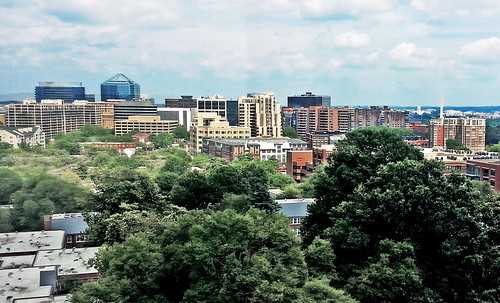
|
|
Blog
I Wish I’d had a better-quality camera last week when I got to enjoy this fantastic view of Rosslyn, the US Capitol, and the Washington Monument. Alas, a cell phone snap is as good as it gets.
 Average Rating: 4.6 out of 5 based on 203 user reviews.
 The European Space Agency recently began broadcasting a real time feed from its Earth-facing camera onboard the International Space Station. You can follow it here, or use the tracker for geographic orientation.
Real-time view from the International Space Station. Live streaming video from Ustream. Average Rating: 4.7 out of 5 based on 235 user reviews.
 When Metrorail’s new Silver Line opens to passengers on July 26, it will soundly beat DC’s H Street streetcar in the unofficial race over which opens first. But one day earlier, a sister project to the DC streetcar will have its day in the sun.
 Tucson’s Sun Link streetcar. Photos by Bill Morrow on Flickr. At 9:00 am on July 25, less than 30 hours before the Silver Line opens, Tucson’s Sun Link streetcar will carry its first passengers. Although Tucson is 2, 000 miles away from H Street, their streetcar project is related to DC’s. Manufacturer United Streetcar built the railcars for both DC and Tucson, and the same factory delays that have slowed delivery of DC’s streetcars also mired Tucson’s. Sun Link was originally supposed to open in October, 2013. Its 10 month late opening is just as frustrating for Arizonans as the late transit openings are for us in the DC region. But frustrations aside, the impending opening dates for the Silver Line and Tucson streetcar are also a light at the end of the tunnel for H Street. Overcoming the obstacles of a big new infrastructure project is hard, and takes a long time, but these projects do eventually open. Average Rating: 4.9 out of 5 based on 159 user reviews.
June 23rd, 2014 | Permalink
 Whoever made this video compilation of “doors closing” chimes from metro lines around the world is a transit geek after my own heart. After watching the video, I have a fresh appreciation for WMATA’s comparatively pleasant choice.
Average Rating: 4.7 out of 5 based on 194 user reviews.
June 20th, 2014 | Permalink
 This December, wireless streetcars will start carrying passengers in Guangzhou, China. The new trams will run using supercapacitor batteries instead of overhead wires.
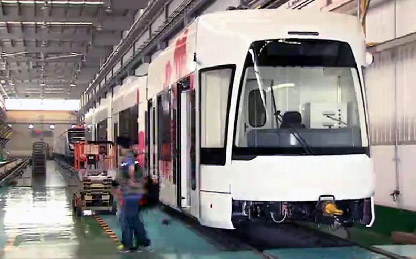 Guangzhou’s wireless tram. Photo from China Central Television. Cities around the world, including Washington, have been increasingly interested in wireless streetcars ever since Bordeaux, France started using them in 2003. But Bordeaux’s trams use an underground third rail that’s proven too expensive for widespread use. The Guangzhou system will use batteries that automatically recharge from an underground power supply at passenger stations. One recharge takes 10-30 seconds, and powers the tram for up to 4 kilometers (2.5 miles). And a similar system is in the works for another Chinese city, Nanjing. That’s good news for DC, where laws prohibit overhead wires at key locations near the National Mall. Streetcars like Guangzhou’s could solve that problem. It’s not clear how much extra this type of wireless tram would cost. Expense doomed the Bordeaux method, so that is a serious concern. But if the price is right, the technology finally seems to be there. Average Rating: 4.4 out of 5 based on 184 user reviews.
June 20th, 2014 | Permalink
 As DDOT begins to crystallize plans for a north-south streetcar, four big questions will drive what the line ultimately looks like: How will the line snake through the center of the city, will it reach Silver Spring, where will there be dedicated lanes, and is there any money to actually build anything?
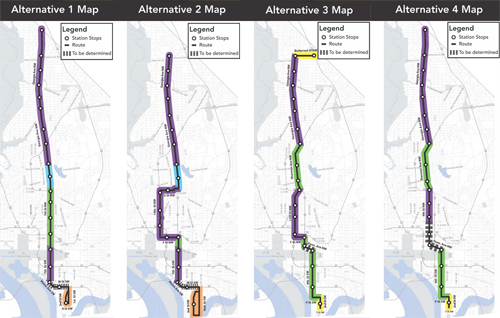 Four route alternatives under study. Dedicated lanes could potentially fit on the purple and light blue sections. Image from DDOT. DDOT’s planners are still months away from settling on final details for the North-South Corridor. But at a series of public meetings last week, these big questions came into focus. How will the line snake through the center of the city? DDOT’s latest report focuses on four potential alternate routes, but project manager Jamie Henson says DDOT could still mix and match components of multiple alternates to create the final path. North of Petworth, DDOT has settled on a Georgia Avenue streetcar alignment going at least as far north as Butternut Street. The line could run south from Petworth down Sherman Avenue as far as Florida Avenue, or it could stay on Georgia. Georgia is wide enough for dedicated lanes and is lined with shops instead of houses, so it would probably attract more riders, but Sherman would offer a more stark contrast to the route 70 Metrobus. South of Florida Avenue things get really interesting. The route could stay on 7th Street through downtown DC, but that duplicates Metrorail’s Green Line, and 7th Street isn’t wide enough for dedicated lanes. Or it could travel on 14th Street, where population density is most concentrated and where it’s a long walk to any Metro stations. But 14th Street is already booming; a streetcar might help more elsewhere. 11th Street and 9th Street are intriguing possibilities. Infill and commercial development have lagged there relative to 14th Street. Would a streetcar bring a 14th Street-like boom? Meanwhile, both 11th and 9th are wide enough for dedicated lanes. 9th Street is already home to one of DC’s only existing bus lanes. Though the bus lane is lightly used and poorly enforced, that might make 9th a particularly easy place to add streetcar lanes.
 Existing 9th Street bus lane. To traverse the National Mall, the line could either turn onto F Street through downtown and then use 7th Street to go south, or it could turn onto Pennsylvania Avenue and then use 4th Street. The F Street to 7th Street option seems to be a path of less resistance, could fit dedicated lanes, would be more central to the National Mall, and would directly serve The Wharf development at the Southwest waterfront. On the other hand, 4th Street would better serve the existing Southwest neighborhood. Will it reach Silver Spring? Silver Spring is a natural end point for this corridor. It’s big, dense, and already one of the DC region’s largest multimodal transit transfer points.
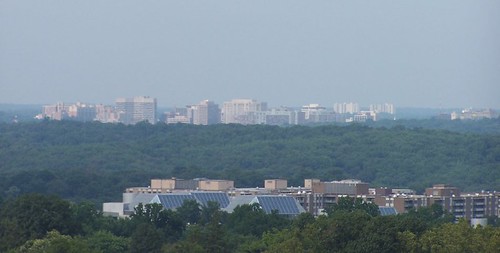 Silver Spring. Around 4, 000 DC-bound passengers board WMATA’s route 70 Metrobus in Silver Spring every day, with still more boarding the parallel S-series routes. There’s tremendous opportunity for the streetcar to reach more people and have a greater impact by ending in Silver Spring instead of DC. But for that to happen, Maryland and Montgomery County have to step up with plans of their own. DDOT has neither authority to plan nor money to build outside the District’s boundaries. So for now, DDOT is keeping its options open. But eventually they’ll need to make a decision. At this point, it’s on Maryland to come to the table. Where will there be dedicated lanes? Whether or not the streetcar will have dedicated lanes depends on two factors: Is there adequate width on the street, and is there enough political support to repurpose lanes from cars? The first factor is easy. This chart shows potential street cross-sections, color-coded to match street segments along the route alternatives maps.
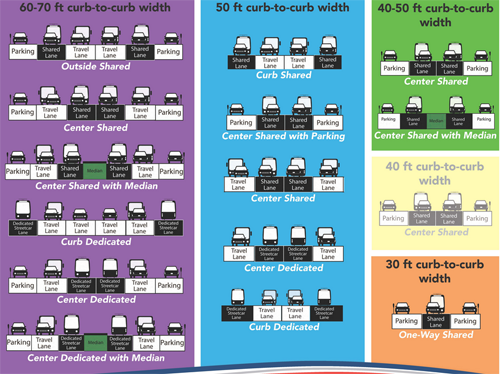 Potential street cross-sections, color-coded to the map above. Image from DDOT. Streets color-coded as either purple or blue are wide enough to potentially fit dedicated lanes. Streets coded as green, yellow, or orange are not. The political factor is harder. Depending on the location, providing dedicated streetcar lanes might mean eliminating or reducing on-street parking, pushing truck loading onto side streets, or any number of other trade-offs. DDOT’s ridership forecasts say shaving 5 minutes off streetcar travel time would boost ridership 11%. If true, that suggests thousands more people would ride a streetcar with dedicated lanes than without. And of course, the inverse is true too: Without dedicated lanes, many riders who could be on the streetcar might instead opt to drive. At public meetings last week, representatives from the Georgia Avenue business community voiced strong objections to dedicated lanes, fearing that loss of parking would hurt their stores. But if dedicated lanes add more streetcar riders to a block than they remove parking spaces, the reverse could very well be true. Is there money to actually build anything? Thanks to Chairman Mendelson and the DC Council cutting streetcar funding in the latest budget, DDOT lacks funding to build this line. It’s possible the council could add more money in future budgets, or DDOT could seek alternate funding options like the federal New Starts program. But for now, this line is unfunded and there’s not yet any apparent strategy to change that. In the meantime DDOT will continue to plan, with the next step being an environmental study. But all other details pale next to the overarching and unanswered question of how to fund whatever the studies recommend. Average Rating: 4.7 out of 5 based on 199 user reviews.
June 19th, 2014 | Permalink
 On San Antonio’s Primo BRT buses, cyclists bring their bikes inside the bus rather than lock them to the front. This speeds up loading and unloading, but reduces Primo’s overall passenger capacity.
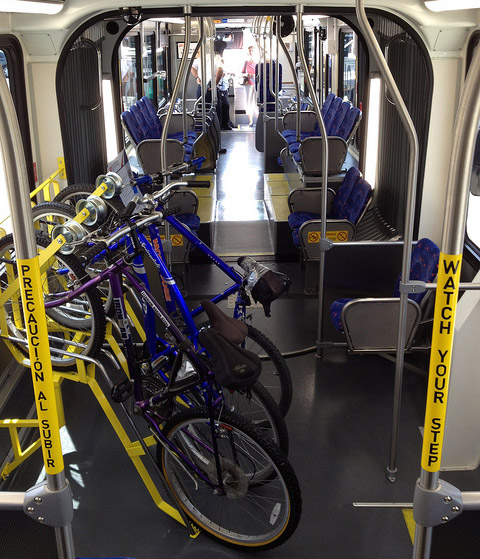 Bike racks on Primo bus in San Antonio. Photo by Stuart Johnson on Flickr. Primo carries about 6, 000 passengers per day, compared to over 20, 000 per day on DC’s 16th Street line. So for Primo, the speed versus capacity trade-off tilts to speed. In DC, our busiest bus lines generally won’t have that option. Although it may make sense in some places, like Montgomery County’s proposed BRT network. For DC’s more crowded lines, where we cannot justifiably sacrifice limited bus capacity to bikes, rail’s greater spaciousness is an increasingly important advantage. With longer vehicles, we get both the speed advantage and the capacity advantage. Of course to really speed up buses or trams, give them a dedicated lane. But even in places where that’s not practical, improvements like longer vehicles, more doors, interior bike racks, and off-vehicle fare collection can make a difference, regardless of mode. Average Rating: 5 out of 5 based on 233 user reviews.
June 17th, 2014 | Permalink
 As more cities build more protected bike lanes, some are beginning to use them as opportunities for public art. In Seattle, the new Broadway cycletrack includes a section with “art bollards.”
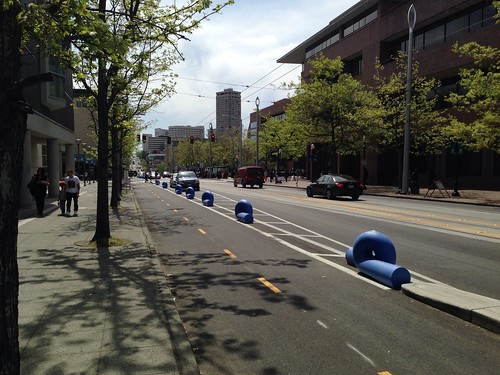 Seattle cycletrack. Photo by Gordon Werner on flickr. Most cycletracks around the US use flexposts or concrete curbs to separate the bike lane from car traffic. A few use other methods like parking stops or zebras, but there are better-looking options available. In addition to Seattle’s art bollards, a growing number of cities use landscaped barriers.
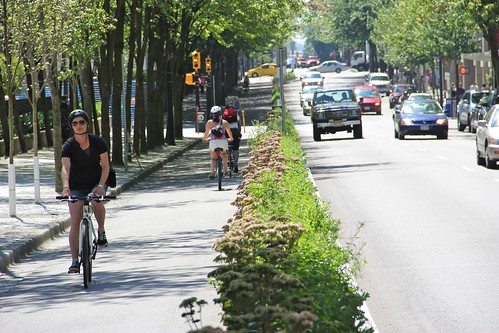 Vancouver cycletrack. Photo by Paul Kreuger on flickr. These are great ideas. As cycletrack networks continue to expand, cities around the country can look for opportunities to make their bike lanes more beautiful. But that being said, beautification adds time and expense to construction, and most cyclists would likely rank having more usable cycletracks sooner as a higher priority than art or landscaping. So art is great, but there’s definitely a place for easy, cheap flexposts. Average Rating: 4.8 out of 5 based on 234 user reviews.
June 16th, 2014 | Permalink

 Average Rating: 5 out of 5 based on 204 user reviews.
June 12th, 2014 | Permalink
 Last night, US House majority leader Eric Cantor lost the Republican primary to a tea party challenger who painted Cantor as too willing to compromise with Democrats. Cantor’s loss makes this summer’s looming congressional fight over transportation funding all the more unpredictable.
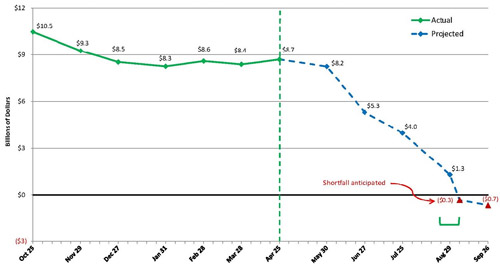 US Highway Trust Fund balance. If Congress doesn’t act soon, money will run out. Image from USDOT. MAP-21, the federal transportation funding bill, expires in October. But USDOT will begin running out of money in August. Without a bipartisan bill to add new money, federal transportation funding will trickle to a halt. Transportation wasn’t a major issue in Cantor’s election, but immigration reform was. Cantor mostly opposed immigration reform, but he briefly contemplated compromise, giving his more conservative opponent David Brat an opening to attack. Some pundits fear that will push every other House Republican away from compromise in general, and grind whatever progress Congress was making on anything to a halt. From an immigration perspective that probably makes little difference; House Republicans were not going to compromise anyway. But it could make a huge difference for transportation. Transportation funding was a non-partisan issue in the 20th Century. Every 6 years Congress would pass a transportation bill with broad support from both parties. But in recent years, amid declining gas tax revenue and increasing need for supplemental funding, transportation has become a partisan spark. Congress seemed primed to act, but now it’s an open question Up until Cantor’s defeat, the general assumption in the transportation world has been that Congress would do something this summer. “Something” might mean a long term solution like a new bill and new taxes. Or it might mean a band-aid, like an extension of MAP-21 with an infusion of federal general fund dollars. Either way, Congress appeared to be making some progress. But now? House Republicans might very well cease all legislative activity, and hope to ride out the rest of election season without upsetting their conservative base. Polls show that raising money for transportation is popular, and voters rarely punish officials for doing so. But that may not matter to Republicans concerned about attacks from the extreme right. While in Congress, Cantor fought against progressive transportation funding. But in this case his personal vote, and even his leadership on the specifics, might be less important than the simple fact that he was probably willing to advance a bill. On the other hand, maybe the Republican establishment will take this as a call to arms, and moderate legislators will become more powerful. But that seems unlikely the day after the biggest tea party victory of the season. Average Rating: 4.9 out of 5 based on 279 user reviews.
June 11th, 2014 | Permalink
 |
Media Tweets by @beyonddc
Follow @beyonddc
Site
Partners
|
|||||||||||||||||||||||||
|